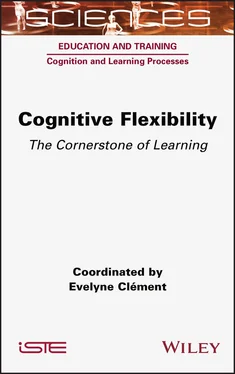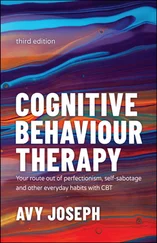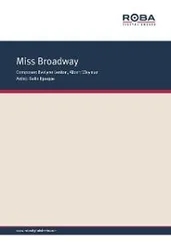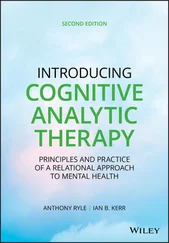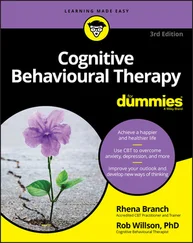Evelyne Clement - Cognitive Flexibility
Здесь есть возможность читать онлайн «Evelyne Clement - Cognitive Flexibility» — ознакомительный отрывок электронной книги совершенно бесплатно, а после прочтения отрывка купить полную версию. В некоторых случаях можно слушать аудио, скачать через торрент в формате fb2 и присутствует краткое содержание. Жанр: unrecognised, на английском языке. Описание произведения, (предисловие) а так же отзывы посетителей доступны на портале библиотеки ЛибКат.
- Название:Cognitive Flexibility
- Автор:
- Жанр:
- Год:неизвестен
- ISBN:нет данных
- Рейтинг книги:4 / 5. Голосов: 1
-
Избранное:Добавить в избранное
- Отзывы:
-
Ваша оценка:
- 80
- 1
- 2
- 3
- 4
- 5
Cognitive Flexibility: краткое содержание, описание и аннотация
Предлагаем к чтению аннотацию, описание, краткое содержание или предисловие (зависит от того, что написал сам автор книги «Cognitive Flexibility»). Если вы не нашли необходимую информацию о книге — напишите в комментариях, мы постараемся отыскать её.
Cognitive Flexibility — читать онлайн ознакомительный отрывок
Ниже представлен текст книги, разбитый по страницам. Система сохранения места последней прочитанной страницы, позволяет с удобством читать онлайн бесплатно книгу «Cognitive Flexibility», без необходимости каждый раз заново искать на чём Вы остановились. Поставьте закладку, и сможете в любой момент перейти на страницу, на которой закончили чтение.
Интервал:
Закладка:
Cognitive flexibility difficulties have also been shown in children with pediatric bipolar disorder (Passarotti et al. 2016). Patients with bipolar disorder have a deficit in cognitive flexibility (O’Donnell et al. 2017).
People with autism spectrum disorders also have flexibility difficulties (Hughes et al . 1994; Reed 2018). Zelazo et al. (2002) showed the possibility of predicting theory of mind difficulties in individuals with autism by their performance in cognitive flexibility.
A deficit in cognitive flexibility has also been demonstrated in depression (Gabrys et al . 2018). Many neurodegenerative diseases can be affected by a cognitive flexibility deficit, with the two most iconic being Alzheimer’s disease (Swanberg et al. 2004) and Parkinson’s disease (Lange et al . 2018).
A measure of cognitive flexibility can therefore be useful in the diagnosis of certain pathologies, whether in children or adults.
1.3. How can we measure flexibility?
Can we really talk about measuring flexibility? What are we really measuring?
As with all executive functions, the measurement of pure flexibility seems unattainable. Regardless of the type of assessment chosen, there is no 100% guarantee that no other cognitive process is involved in a situation that is supposed to measure flexibility.
Therefore, we should say that a flexibility task predominantly assesses or involves flexibility to a greater extent than other executive functions, or even other cognitive processes, rather than suggesting that only flexibility is measured in this test. For example, the Trail Making Test (TMT) (Reitan and Wolfson 1993), in which we have to switch from processing a sequence of letters to processing a sequence of numbers, requires flexibility, but also inhibition, because in order to switch to the sequence of numbers, we must inhibit the sequence of letters.
1.3.1. The different types of assessment
Many criteria could be used to classify the different types of flexibility assessment. The population concerned, the more or less ecological nature of the situation used, whether it is spontaneous or reactive flexibility (Eslinger and Grattan 1993; see also Chapter 5), etc., are all criteria that could allow such a classification. In this section, we have chosen to focus on the distinction based on the type of measurement.
In the context of flexibility measurement, as in many other assessments, two main types of measurements can be used: direct measurements and indirect measurements. Measures that can be called “direct” correspond to all situations that involve an assessment of flexibility capacities through a concrete situation (a task constructed in the laboratory, in general, or a more ecological situation).
We will present the different types of direct tasks in a first part, without claiming to be exhaustive. We will see that within these tasks, different subtypes can be identified. The second type of measurement can be called “indirect”, as it is carried out by questionnaire. The questionnaire can either be filled in by the person themselves, in the case of self-assessments, or by a third party (a relative or a carer for example), in the case of hetero-assessments.
Both types of measurement have their advantages and disadvantages. Direct measurements allow an individual measurement at a given time of the individual’s flexibility; this measurement is precise and does not involve the subjectivity of any third party. Therefore, they seem more reliable and representative than indirect measurements, but they have the disadvantage of being more time consuming, and of not being able to be offered to all individuals (for example, very young children, very old people, people with certain pathologies or disabilities).
In contrast, indirect measurements are quicker and less costly to implement. They make it possible to obtain a representation of the various people close to the individual (family, caregivers, teachers, etc.) – or of the individual themselves – of their flexibility. However, they necessarily involve their subjectivity and may therefore be biased and less representative of reality.
1.3.1.1. Direct evaluations
1.3.1.1.1. Historical and classical tasks
One of the best known measurements of flexibility, or at least the most widely used and cited in this field, is the Wisconsin Card Sorting Test (WCST; Grant and Berg (1948)). This task consists of sorting cards, in which no explicit instructions are given and the sorting rule must be inferred on the basis of feedback (correct sorting or not). Once the rule is found, a rule change is performed and the task involves discovering the new sorting rule. The sorting rules are based on perceptual criteria of the elements present on the cards such as color, shape or number. As Miyake (2000) pointed out, the WCST seems to be much more than a test of cognitive flexibility and, according to him, corresponds to a test of high-level executive function, certainly involving cognitive flexibility, but not only this. This task has been considered by different researchers as an inhibition task, a problem-solving task, a categorization task, or other.
Based on the same principle of switching from one process to another on a series of items, several tasks have been proposed that attempt to target an assessment of cognitive flexibility more directly. One of these, often considered a WCST for children, was originally proposed as a flexibility task for preschoolers: the Dimensional Change Card Sort (DCCS) by Frye et al. (1995) – for a recent meta-analysis on this task, see Doebel and Zelazo (2015). In this test, the child must sort two types of test cards (red boats and blue rabbits), matching them to two target cards (a blue boat and a red rabbit). The test consists of two blocks. In the first block, the child must sort the test cards along one dimension (color or shape) and in the second block, the child must sort the same test cards along the other dimension. The instruction is repeated at each trial and the change of dimension is explicitly announced.
We can also mention the Brixton Spatial Anticipation Test, by Burgess and Shallice (1996), which is a test quite similar to the WCST. This test consists of a prediction of displacement according to a rule to be discovered. The rule changes during the test and thus requires the discovery of the new rule. This version is often considered less time consuming than the WCST and more accessible to patients. This test has been adapted for preschoolers by Lehto and Uusitalo (2006) (Brixton Preschool). The child has to predict the spatial location of a character that changes at each trial according to a rule to be discovered on the basis of feedback. In this version, a change of rule also occurs during the test.
The common feature of the above tests is that they require flexible switching from one rule to another on a set of items. Other tasks, on the other hand, require a change in stimulus processing, not between several blocks of items, but from one item to another. One example is the “plus minus” task (Jersild 1927), which compares the performance obtained when performing simple operations (addition or subtraction) without the need to switch to those obtained when performing a series of operations involving a systematic switch between these two simple operations.
This procedure can be seen as the basis of the task switching paradigm, which is used in a great deal of research on processing flexibility in adults (Mayr 2001; Monsell 2003; Schuch and Koch 2003; Mayr and Bell 2006).
Other tasks built on this task switching format can be cited as classic cognitive flexibility tasks and are still widely used, such as the number-letter task (Rogers and Monsell 1995). In this task, pairs of numbers and letters (e.g. 4F) are presented either at the top or bottom of a screen. Depending on the location of the number-letter pair on the screen (top or bottom), a question has to be answered about the number (even or odd?), or about the letter (consonant or vowel?).
Читать дальшеИнтервал:
Закладка:
Похожие книги на «Cognitive Flexibility»
Представляем Вашему вниманию похожие книги на «Cognitive Flexibility» списком для выбора. Мы отобрали схожую по названию и смыслу литературу в надежде предоставить читателям больше вариантов отыскать новые, интересные, ещё непрочитанные произведения.
Обсуждение, отзывы о книге «Cognitive Flexibility» и просто собственные мнения читателей. Оставьте ваши комментарии, напишите, что Вы думаете о произведении, его смысле или главных героях. Укажите что конкретно понравилось, а что нет, и почему Вы так считаете.
